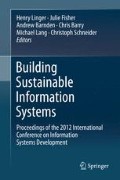Abstract
Enterprise architecture (EA) is present at every company; however, just few organizations have their architecture formalized and manage it to meet their strategic goals. EA creates opportunity for an effective interaction between business and ITC world. Moreover, EA serves as the blueprint for a company and the process which defines it. This paper formulates problem with current approach describing an enterprise and shows that service orientation is a key to coherent enterprise architecture description. We briefly discuss enterprise architecture cohesion and propose method how to measure the level of cohesion within enterprise architecture layers. Main contribution of this paper consists in a comparison and analysis of the chosen frameworks (ArchiMate, Zachman, TOGAF, and DoDAF) based on cohesion viewpoint. Conclusions made by authors could serve as guidance for particular framework extension with the aim to gain coherent enterprise description.
Access this chapter
Tax calculation will be finalised at checkout
Purchases are for personal use only
Notes
- 1.
Information and communication technologies
- 2.
In this paper, we use term segment architectures and enterprise architecture layers as synonym.
- 3.
ArchiMate is an open and independent enterprise architecture modeling language that offers a support for describing the construction and operation of business processes, organizational structures, information flows, IT systems, and technical infrastructure [14].
References
Blowers M (2011) iServer Solutions: using TOGAF9 and industry models to avoid “reinventing the wheel”. http://www.orbussoftware.com/downloads/reports-and-publications/ovum-group-white-paper-iserver-solutions. Accessed 28 Nov 2011
IT Governance Institute (2006) Board briefing on it governance, 2nd edn. http://www.isaca.org/Content/ContentGroups/ITGI3/Resources1/Board_Briefing_on_IT_Governance/26904_Board_Briefing_final.pdf. Accessed 10 Dec 2011
IBM (2007) Building SOA solution using the rational SDP. IBM Corp, Riverton NJ
Chen P, Han J, Tang A (2004) A comparative analysis of architecture frameworks. In: Proceedings of the 11th Asia-Pacific software engineering conference, IEEE, Piscataway, NJ, pp 640–647, 30 Nov–3 Dec
ISACA (2011) COBIT, control objectives for information and related technology (COBIT), 4.1 edn. IT Governance Institute, Rolling Meadows, IL. http://www.isaca.org/cobit.htm. Accessed 13 Dec 2011
DoDAF (2011) DoDAF: DoD Architecture Framework Version 2.02. http://cio-nii.defense.gov/sites/dodaf20/products/DoDAF_v2-02_web.pdf. Accessed 2 Dec 2011
Doest H, Iacob M, Lankhorst E et al (2004) Viewpoints functionality and examples. https://doc.telin.nl/dsweb/Get/Document-35434/. Accessed 10 Jan 2012
Doucet G, Gøtze J et al (2008) Coherent management: using enterprise architecture for alignment, agility, and assurance. http://siteresources.worldbank.org/EXTEDEVELOPMENT/Resources/JEA_May_2008_Coherency_Management.pdf?resourceurlname=JEA_May_2008_Coherency_Management.pdf. Accessed 3 Jul 2012
Shah H, Kourdi ME (2007) Frameworks for enterprise architecture. It Professional 9(5):36–41
Emery D, Hilliard R (2009) Every architecture description needs a framework: expressing architecture framework using ISO/IEC 42010*. http://mysite.verizon.net/rfh2/writings/emery-hilliard2009.pdf. Accessed 28 Dec 2011
Institute for enterprise architecture developments (2010) Enterprise architecture standards overview. Institute for enterprise architecture developments. http://www.enterprisearchitecture.info/EA_Standards.htm. Accessed 26 Dec 2011
The Chief Information Officers Council (1999) FEAF (Federal Enterprise Architecture Framework), version 1.1. The Chief Information Officers Council. http://www.cio.gov/Documents/fedarch1.pdf. Accessed 25 Nov 2011
Grembergen W (2005) Measuring and demonstrating the value of IT. IT Governance domain practices and competencies. IT Governance Institute, Rolling Meadows, IL
Lankhorst M, Drunen H (2007) Enterprise architecture development and modelling. Via Nova Architectura. http://www.via-nova-architectura.org/files/magazine/Lankhorst.pdf. Accessed 15 Nov 2011
Lankhorst M (2005) Enterprise architecture at work—modelling, communication, and analysis. Springer, Berlin
McDavid D (2000) The Business-IT gap: a key challenge http://www.almaden.ibm.com/coevolution/pdf/mcdavid.pdf. Accessed 16 Nov 2011
The Open Group (2012) ArchiMate® 2.0 Specification. Open Group Standard http://pubs.opengroup.org/architecture/archimate2-doc/. Accessed 20 Mar 2012
Sessions R (2007) A comparison of the top four enterprise-architecture methodologies. MSDN Architecture Center. http://msdn.microsoft.com/en-us/library/bb466232.aspx. Accessed 15 Sep 2010
The Open Group. TOGAF: The Open Group Architecture Framework. The Open Group. http://www.opengroup.org/architecture/togaf9/downloads.htm. Accessed 11 Dec 2011
Triantaphyllou E (2000) Multi-criteria decision making: a comparative study. Kluwer Academic Publishers (now Springer), Dordrecht
Velitchkov I (2008) Cohesion of enterprise models. Via Nova Architectura. http://www.via-nova-architectura.org/magazine/magazine/cohesion-of-enterprise-models-3.html Accessed 14 Feb 2012
Acknowledgments
This research has been supported by GACR (Grant Agency, Czech Republic) grant No. P403/10/0303, Enterprise Architecture as Management Principle for SMEs.
Author information
Authors and Affiliations
Corresponding author
Editor information
Editors and Affiliations
Rights and permissions
Copyright information
© 2013 Springer Science+Business Media, LLC
About this paper
Cite this paper
Selcan, V., Buchalcevova, A. (2013). An Analysis of Enterprise Architecture Frameworks from a Coherent Enterprise Description Viewpoint. In: Linger, H., Fisher, J., Barnden, A., Barry, C., Lang, M., Schneider, C. (eds) Building Sustainable Information Systems. Springer, Boston, MA. https://doi.org/10.1007/978-1-4614-7540-8_40
Download citation
DOI: https://doi.org/10.1007/978-1-4614-7540-8_40
Published:
Publisher Name: Springer, Boston, MA
Print ISBN: 978-1-4614-7539-2
Online ISBN: 978-1-4614-7540-8
eBook Packages: Computer ScienceComputer Science (R0)

